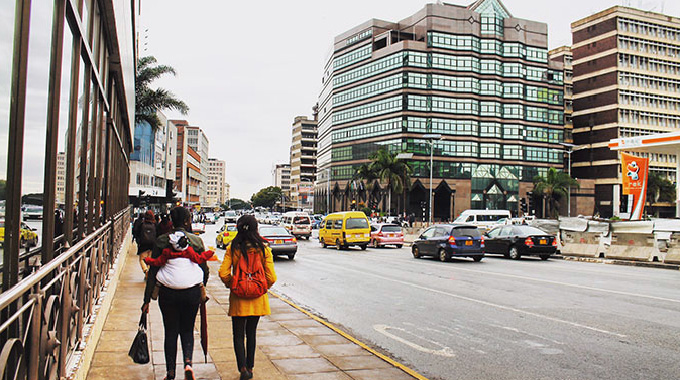Irrigation scheme stirs Tuli farmers’ hope

Sifelani Tsiko
A view of a large lush green field of maize at the Tuli-Lushongwe irrigation scheme in Gwanda district, about 160km southeast of Bulawayo, Zimbabwe’s second largest city, helped Pretty Ncube to stay positive even when she felt the whole world was falling apart at some point.
It means a lot to her. It announces the good times, good news and plenty of food.
In this drought prone district, it’s a firm indication that what you are doing in daily life will produce good results.
“Our maize is now ripe and very soon we will be selling it in Gwanda,” says Ncube, chairwoman of the Tuli-Lushongwe irrigation scheme.
“I’m quite excited about it. I never knew we could get such a crop. I want to thank FAO (the Food and Agriculture Organisation) and their partners for reviving our irrigation scheme. This is a genuine gift that is improving our lives. Siyathokoza kakhulu loncedo lolu.”
Tuli-Lushongwe is part of 10 irrigation schemes in Matabeleland South province that have benefited under the FAO smallholder irrigation support programme meant to help boost crop output and improve food security in this dry region south of Zimbabwe.
The rehabilitation programme is funded by the European Union (EU) and the FAO is facilitating the programme working together with the Zimbabwe government.
In 2014, Matabeleland province was allocated three million euros under the programme which sought to rehabilitate irrigation schemes that had been abandoned, leaving several communities exposed to drought.
The Tuli-Lushongwe scheme last had activity almost a decade ago before the irrigation scheme collapsed and left communities in this drought prone area with no source of food but to depend on handouts.
Museve Bwerinofa, a FAO Matabeleland South provincial facilitator for the small irrigation support programme, says he is hopeful the rehabilitation programme will ease the perennial problem of food shortages in this region.
“The intention is to assist farmers to feed themselves, the country and then make money for themselves to improve their livelihoods,” he says.
“A solar water pump has made a huge difference for the farmers in addition to the rehabilitation of canals and other infrastructure here at Tuli-Lushongwe.”
Angelina Dube, a farmer from Lushongwe ward 9, is upbeat.
“This is great work and we are reaping huge rewards from this scheme now,” she says.
“Water, water and water alone has made a huge difference. Over a short period of time, we have managed to turn a neglected and abandoned bush into a field of lush green maize.
“We had lost hope, but with a new solar pump, new water canals, tractors and inputs we got, we are now hopeful about the future.”
Before the scheme was rehabilitated they grew crops on a 2,5 hectare piece of land using expensive diesel powered water pump.
Now, the farmers are tilling 25 hectares of land and they want to venture into the growing of potatoes and beans.
Ncube says they expect to earn more than US$500 from the sale of green mealies alone.
The Government has been supportive too. It provided the 50 member irrigation scheme with a tractor and other farm implements in addition to extension work.
“When the irrigation scheme collapsed, there was nothing here,” says Pretty Dube, another farmer at the scheme.
“There was no water. Crops wilted and life here was pathetic. This is our first harvest in years and I’m excited about it. It means a lot to us and our children.”
Most of the farmers believe the revival of the irrigation scheme will reduce border jumping by their children into South Africa, across the crocodile infested Limpopo River.
“The revival of this irrigation scheme has prevented me from crossing into South Africa where we work on farms for peanuts,” says Thambilini Ncube, another farmer.
“There is nothing Egoli (South Africa) and schemes like this are certainly good in stopping our children from crossing the border. We get food and we sell some to earn a living.
“It was hard work clearing the bush, but we are reaping the rewards. We have no reason to leave this rich land of ours. We have cattle and what we need is maize, beans, potatoes and other crops that we can sell to people in Gwanda and Beitbridge.”
Most of the members say they will pay school fees for their children with earnings they will get.
Some even say they want to buy cattle to boost their livestock assets.
Experts say agriculture employs more than 60 percent of Africa’s working population, but low productivity and high levels of food insecurity persist.
They urge African governments to prioritise small-scale irrigation schemes and other forms of agricultural water management strategies that are critical in building resilience to problems that come with climate change.
Zimbabwe just like most other African countries is endowed with abundant water resources that are however unevenly distributed across the country.
Very few farmers benefit from water management and the majority still rely heavily on rain-fed agriculture.
Lushongwe is becoming highly vulnerable to climate change and farmers across this region increasingly need to rely more on climate change adaptation options such as irrigation to survive.
In this region, dry spells and significant climate events such as droughts are hitting smallholders more frequently and FAO and all its partners say there is an urgent need to adapt irrigation techniques.
Smallholder farmers in this area also believe that small-scale irrigation is the way out of poverty.
They say it will enable them to achieve more reliable, profitable and sustainable production, increase their resilience and their livelihoods.
In this light, small-scale irrigation is very promising for many here in Lushongwe as it promotes rural food security, poverty alleviation and adaptation to climate change.
With inadequate and erratic distribution of rainfall, the Government and agriculture experts all agree that the development of irrigation is key to unlocking the country´s agricultural potential.
Despite the threats of drought and erratic rainfall, experts say increasing the amount of water for agriculture through water storage at all levels from field to reservoir is part of the solution.
Managing water resources better is also vital they say, particularly now when drought is ravaging areas like Lushongwe.
“The challenge across this region is to draw the water to where it’s needed most and to use it in the most effective and sustainable way possible,” says Bwerinofa.
“This region is dry and adopting water management practices to a local context is crucial.”
This, he says, will improve resilience by bridging the dry spells that are getting more frequent during the farming season and opening up opportunities for additional dry-season agricultural production.
Achieving food security in Zimbabwe is a critical issue, even as efforts are stymied by drought, floods and other factors.
The challenge of a changing climate is hitting the country’s poor farmers hardest and it is through schemes such as the Tuli-Lushongwe that can offer relief and a sure way out of food insecurity.
Experts and Government all agree that a proven way to expand agriculture and food production in Zimbabwe is to focus on scaling up irrigation programmes, bringing water to parched lands, and strengthening the hands of farmers who produce food against climatic odds.
It is estimated that as little as 7 percent of the continent’s arable land is irrigated – or artificially watered while the rest of the continent’s crop lands are subject to the vagaries of erratic rainfall patterns.
This means that when there is a drought, there is no production on smallholder farm lands, forcing people to rely on costly imports or cross the border into South Africa and Botswana in search of jobs.
Irrigations is key. Investments in pipes, solar water pumps and canals that help water flow to dry areas, and in other large-scale multi-purpose dams that provide water and control flooding, can help bring relief to drought-prone regions.
They can help blunt the worst effects of drought.
Zimbabwe needs about $427,5 million for the rehabilitation of 57 000 hectares at non-functional irrigation schemes which are in a deplorable state after years of neglect, vandalism and poor maintenance.
The total developed irrigated area in 2000 was estimated at 200 000 hectares, accounting for 80 percent of national water demand. By 2017, it was estimated that 206 000 hectares of the developed 263 000ha was functional.










Comments